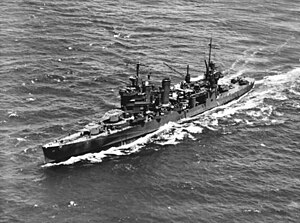
Back USS Astoria (CA-34) Czech USS Astoria (CA-34) German USS Astoria (CA-34) Spanish یواساس آستوریا (سیای-۳۴) Persian USS Astoria (CA-34) French USS Astoria (CA-34) Italian アストリア (重巡洋艦) Japanese USS Astoria (CA-34) Polish USS Astoria (CA-34) Portuguese USS Astoria (CA-34) Vietnamese
 USS Astoria (CA-34), operating in Hawaiian waters during battle practice, 8 July 1942. She appears to be recovering floatplanes from off her starboard side. Note booms rigged below the forward superstructure to tow aircraft recovery mats, and starboard crane swung out.
| |
| History | |
|---|---|
| Name | Astoria |
| Namesake | City of Astoria, Oregon |
| Ordered | 13 February 1929 |
| Awarded |
|
| Builder | Puget Sound Navy Yard, Bremerton, Washington |
| Cost | $11,951,000 (limit of price) |
| Laid down | 1 September 1930 |
| Launched | 16 December 1933 |
| Sponsored by | Miss Leila C. McKay |
| Commissioned | 28 April 1934 |
| Reclassified | CA-34, 1 July 1931 |
| Identification |
|
| Nickname(s) | "Nasty Asty"[1] |
| Honors and awards | |
| Fate | Sunk during the Battle of Savo Island 9 August 1942 |
| General characteristics (as built)[2] | |
| Class and type | New Orleans-class cruiser |
| Displacement | 9,950 long tons (10,110 t) (standard) |
| Length | |
| Beam | 61 ft 9 in (18.82 m) |
| Draft |
|
| Installed power |
|
| Propulsion |
|
| Speed | 32.7 kn (37.6 mph; 60.6 km/h) |
| Capacity | Fuel oil: 1,650 tons |
| Complement | 104 officers 795 enlisted |
| Armament | |
| Armor |
|
| Aircraft carried | 4 × floatplanes |
| Aviation facilities | 2 × Amidship catapults |
| General characteristics (1942)[3] | |
| Armament |
|
The second USS Astoria (CL/CA-34) was a New Orleans-class cruiser of the United States Navy that participated in both the Battle of the Coral Sea and the Battle of Midway, but was then sunk in August 1942, at the Battle of Savo Island. Astoria was the first New Orleans-class cruiser to be laid down but launched after and received a hull number higher than the lead ship New Orleans.
Immediately after the months-long Guadalcanal campaign ended in February 1943, the remaining ships of the class would go through major overhauls to lessen top-heaviness due to new electrical and radar systems and advanced anti-aircraft weaponry. In doing so the ships took on a new appearance, most notably in the bridge.
- ^ "Ship Nicknames". zuzuray.com. Retrieved 6 October 2015.
- ^ "Ships' Data, U. S. Naval Vessels". US Naval Department. 1 July 1935. pp. 16–23, 338. Retrieved 6 October 2015.
- ^ "US Cruisers List: Light/Heavy/Antiaircraft Cruisers, Part 1". Hazegray.org. 22 January 2000. Retrieved 6 October 2015.
© MMXXIII Rich X Search. We shall prevail. All rights reserved. Rich X Search